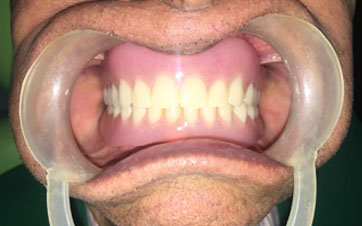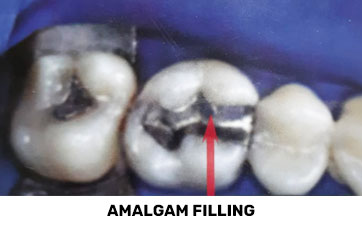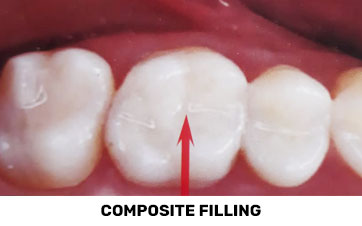Dental Cleaning
The AGD strongly recommends that a dentist perform a dental cleaning every six months. This professional dental cleaning reinforces the home-care oral health regimen of brushing and flossing and gives the dentist an opportunity to locate areas in the mouth that may need special attention.
During a dental cleaning, you'll receive diagnostic and preventive services from your dentist as well as any needed educational information.
Diagnostic services may include
- Reviewing and updating medical history, including information about heart problems, pregnancy, diabetes and medications, which may have an impact on your oral health
- Oral cancer examination and screening
- Evaluation of gum tissue
- Checking biting, chewing and swallowing patterns
- X-rays or examination of teeth to detect decay
- Referral to specialists for specific treatment
Preventive services may include
- Removal of plaque and tartar
- Stain removal
- Fluoride application
- Sealants (for children)
- Polishing teeth, including fillings and crowns
- Cleaning and adjustment of dentures and partial dentures
Educational services may include
- Tooth brushing and flossing instructions
- Nutritional counseling
- Recommendations for future treatment: when to return for follow-up hygiene treatment, periodontal (gum) concerns or restorative options
- Evaluation of self-care effectiveness
- Tobacco-cessation counseling
Dental Fillings
A filling is a way to restore a tooth damaged by decay back to its normal function and shape. If you have a tooth that requires a filling, the dentist will first remove the decayed tooth material, clean the affected area, and then fill the cleaned out cavity with a filling material. A filling also helps prevent further decay by closing off any cracks or spaces where bacteria can enter.
Composite (plastic) resins are custom made to the exact color of your natural teeth, creating a more natural appearance. They may not be ideal for large fillings as they may chip or wear over time. They can also become stained from coffee, tea or tobacco.
Dentures & Partial Dentures
A denture is a removable replacement for missing teeth and surrounding tissues. Two types of dentures are available -- complete and partial dentures. Complete dentures are used when all the teeth are missing, while partial dentures are used when some natural teeth remain.
Complete Dentures
Complete dentures can be either "conventional" or "immediate." Made after the teeth have been removed and the gum tissue has begun to heal, a conventional denture is ready for placement in the mouth about eight to 12 weeks after the teeth have been removed.
Unlike conventional dentures, immediate dentures are made in advance and can be positioned as soon as the teeth are removed. As a result, the wearer does not have to be without teeth during the healing period. However, bones and gums shrink over time, especially during the healing period following tooth removal. Therefore a disadvantage of immediate dentures compared with conventional dentures is that they require more adjustments to fit properly during the healing process and generally should only be considered a temporary solution until conventional dentures can be made.
Partial Dentures
A removable partial denture or bridge usually consists of replacement teeth attached to a pink or gum-colored plastic base, which is connected by metal framework that holds the denture in place in the mouth. Partial dentures are used when one or more natural teeth remain in the upper or lower jaw. A fixed (permanent) bridge replaces one or more teeth by placing crowns on the teeth on either side of the space and attaching artificial teeth to them. This "bridge" is then cemented into place. Not only does a partial denture fill in the spaces created by missing teeth, it prevents other teeth from changing position. A precision partial denture is removable and has internal attachments rather than clasps that attach to the adjacent crowns. This is a more natural-looking appliance.
Are There Alternatives to Dentures?
Yes, dental implants can be used to support permanently cemented bridges, eliminating the need for a denture. The cost is usually greater, but the implants and bridges more closely resemble the feel of real teeth. Dental implants are becoming the alternative to dentures but not everyone is a candidate for implants. Call us today for consultation.
Periodontics - Treatment of Gum disease
Healthy teeth begin with healthy gums, so if you're suffering from bleeding, sensitive or swollen gums, bad breath, or teeth that seem to have moved, it may be time to take a closer look at your gums.
At Shashwatt Dental we can give you advice on how to prevent gum (periodontal) disease, bleeding gums & dental decay. Regular visits to your dentist will ensure that any problems are identified quickly so that you can stop gum disease in its tracks.
If left untreated, gum disease can lead to tooth loss, but our dentist will work with you to rectify gum problems & repair any damage to your teeth or jaw that might already have occurred. We may advise you on a long-term treatment plan to ensure you maintain good oral health over the coming years & you'll receive excellent guidance on how to look after your gums & teeth.
We can even provide you with dietary advice & instructions on how best to brush & floss your teeth so that you avoid the build-up of plaque that can cause gum disease. With healthy gums & a fresh mouth you'll feel on top of the world.
What is gum disease?
Periodontal disease, commonly known as gum disease, is a chronic bacterial infection of the gums & bone supporting the teeth. It is a major cause of tooth loss in adults, however, because gum disease is usually painless, you may not even know you have it.
Although most individuals suffer gum inflammation from time to time, according to research around 10-15% of the population appear to suffer from the more severe forms of the disease, which causes loss of supporting bone. This group of people appears to be at greatest risk of losing teeth through periodontal disease.
What are the causes of gum disease?
The main cause of gum disease is the formation of dental plaque, which is a sticky film on the tooth surface. The bacteria contained in plaque release toxins that can damage the gums. If plaque is allowed to accumulate, it causes inflammation of the surface of the gums which is known as ‘Gingivitis’. This inflammation will resolve if the plaque is removed through cleaning of the teeth & no permanent damage is done.
As the amount of plaque increases it can begin to mineralise & form tartar (calculus). Such hard deposits have a rough surface & allow more plaque to form & cause further damage to the gums.If plaque accumulates for a long time the changes it causes in the gums can lead to loss of the bone support, a condition known as Periodontitis
How do I know if I have gum disease?
The signs & symptoms of periodontal disease are variable but may include reddening & swelling of the gums, gums that bleed on brushing, gums that have pulled away from the teeth together with evidence of loose teeth, a bad taste in the mouth & possibly also bad breath. However, because pain is rarely a symptom until the disease is at an advanced stage, it is possible to you might be unaware of any changes.
It is advisable to attend a general dental practitioner regularly so that special assessment techniques to detect changes in the gums, sometimes including x-rays, can be carried out as part of your routine dental examination.
Consultation
The first stage periodontal treatment is the consultation appointment. It is important for the ultimate success of any treatment that the severity & extent of the disease are established in advance. This is done by carefully measuring the position of the gums & whether or not spaces have developed between the gums & teeth (these spaces are called pockets). The depths of these pockets are registerd on a special chart, which gives a permanent record of the level of disease present. As well as recording this chart a consultation also involves the taking of photographs & any necessary x-rays, which show the position & height of the bone supporting the teeth.
Once all the information has been collected, a treatment plan can be devised. Whenever possible, various treatment options will be presented & their merits & potential drawbacks discussed. By the end of the consultation you should feel fully informed about your condition & have an understanding of the treatment options available to you, as well as the likelihood of success.
Treatment of gum disease
Possible treatment alternatives will be explained to you at your consultation appointment. This is the best time to ask any questions you may have.Our aim is always to preserve teeth if possible & advisable.
The most common form of treatment consists of Scaling & Root planing. Scaling refers to the professional removal of soft plaque & hard calculus (tartar) from the teeth & around the gum line. It is undertaken using h& instruments (scalers or curettes) &/or sonic/ultrasonic instruments which use high frequency vibrations to help remove these deposits.Root planing is really an extension of scaling, which involves removing deposits from under the gum line. This is usually undertaken once the gum tissues are numbed with a dental anaesthetic, so that the treatment can be performed painlessly. The aim is to provide a clean, smooth, tooth & root surface in order that the gum tissue/ attachment has a chance to heal.Scaling & root planing may sometimes be combined with the use of antibiotics to assist in the management of the gum infection.
Before
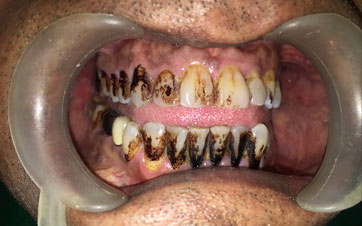
After
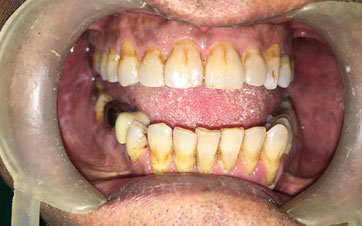
Before
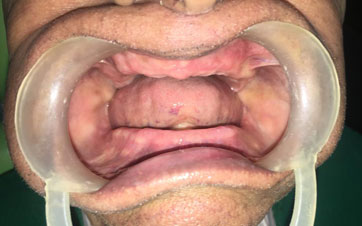
After
